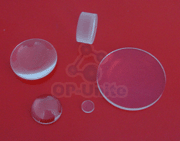|
Lens

Lenses have many applications in range from the simple collection of the scanning of laser beams to precise imaging and image transferring. Lenses are classified as singlet, cylindrical, achromatic and ball lens according to the differentapplications.
Selecting the proper lens for your application requires making a number of choices. A few of the many considerations include: lens shape, conjugate ratio, f/number, transmission, wavefront distortion, scattered light, anti-reflection coating, and cost.
Featured Material: For application in the visible and infrared up to about 2.1 μm, BK7 offers excellent performance at a good value. In the ultraviolet down to 195 nm, UV Fused Silica is a good choice. UV Fused Silica also has excellent transmission in the visible and infrared up to about 2.1 μm, better homogeneity, and a lower coefficient of thermal expansion than BK7. CaF2 and MgF2 offer high transmission in the deep UV, and they are excellent choices for deep UV excimer laser or infrared applications. Silicon and Germanium lenses are widely used in IR applications.
Material |
Transmission Range |
Cost |
Features |
BK7 |
0.390~2.100nm |
Low |
High transmission for visible to near infrared applications, the most common optical glass |
UV Fused Silica |
0.160~2.100um |
Moderate |
Excellent homogeneity and low thermal expansion, high laser damage resistance |
CaF2 |
0.150~9.000um |
High |
High transmission for deep UV to infrared applications |
CZ Silicon |
0.120~100.0um |
Moderate |
High thermal conductivity and low density, excellent for infrared applications. |
Germanium |
1.900~17.00um |
High |
Excellent for infrared applications |
Optical surfaces requirements: The lens application drives the requirements for surface irregularity and surface quality.
Surface Irregularity |
Figure |
Cost |
Applications |
λ/2 |
Low |
Used where wavefront distortion is not as important as cost |
λ/4 |
Moderate |
Excellent for most general laser and imaging applications where low wavefront performance must be balanced with cost |
λ/8 |
High |
For laser and imaging applications requiring low wavefront distortion, especially in systems with multiple elements |
Surface Quality |
Scratch-Dig |
Cost |
Applications |
60-40 |
Low |
Used for low power laser and imaging applications where scattered light is not as critical as cost |
40-20 |
Moderate |
Excellent for laser and imaging systems with focused beams that can tolerate little scattered light |
20-10 |
High |
For demanding laser and imaging systems where minimizing scattered light is critical |
Antireflection Coatings: We offer an extensive range of antireflection coatings covering the ultraviolet, visible, near infrared, and infrared regions. Please refer to our coatings chapter.
Lenses are the most regular components that OP-Unite is making. We can reach very high quality but low price, and we can be competitive for any suppliers in the world. OP-Unite processes thousands of radius Testing Plate for fabricating lenses in stock.
Manufacturing Tolerances
Tolerances |
Commercial quality |
Precision quality |
Manufacturing limits |
Glass Quality |
Nd |
+/-0.001 |
+/-0.0005 |
Melt controlled |
Vd |
+/-0.8% |
+/-0.3% |
Melt controlled |
Diameter(mm) |
+0/-0.10 |
+0/-0.02 |
+0/-0.01 |
Center Thickness(mm) |
±0.10 |
±0.05 |
±0.01 |
SAG (mm) |
±0.050 |
±0.025 |
±0.010 |
Radius |
±2% |
±0.5% |
±0.025% |
Scratch-Dig |
80-50 |
40-20 |
10-5 |
Power (fringe) |
8 |
3 |
1 |
Irregularity (fringe) |
3 |
1 |
0.2 |
Wedge Lens (ETD, mm) |
0.05 |
0.01 |
Facility controlled |
Bevels |
Upon requirement |
No bevel |
Coatings |
Upon requirement |
Note: The general tolerance specifications above provide a guideline regarding manufacturing capabilities for optics ranging in size from 1-200mm. The manufacturing limits are not absolute; tighter tolerances may be possible. Part specific tolerances may vary depending on component size, shape, and/or material. |